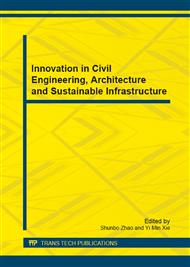p.181
p.185
p.190
p.196
p.201
p.209
p.214
p.218
p.223
Analysis on Load Stress of Asphalt Pavements with Different Crack States
Abstract:
Semi-rigid base asphalt pavement has well load-bearing capacity if no cracks occur. But cracks appear inevitably at the weak part of the structure. Models under different working conditions are set up with the finite element method (FEM) to analyze the stress distribution in the structure while the cement-stabilized macadam-base asphalt pavement encounters different crack states and interface conditions. The analysis indicates that the interlayer cohesion is the key factor affecting the spread of cracks. When the cohesion between the surface and base is weak, the tensile and shear stresses at the bottom of the surface course increase rapidly and both transverse cracks from the bottom to the top and longitudinal cracks in traffic direction come into being in the asphalt surface even though the base doesn’t crack; those transverse cracks which haven’t spread through the base in depth direction will reflect to the surface course under load. The reflected cracks can be reduced and stayed if the surface course is covered after the shrinking cracks in the base course have fully spread and been cured.
Info:
Periodical:
Pages:
201-206
Citation:
Online since:
November 2012
Authors:
Keywords:
Price:
Сopyright:
© 2012 Trans Tech Publications Ltd. All Rights Reserved
Share:
Citation:


